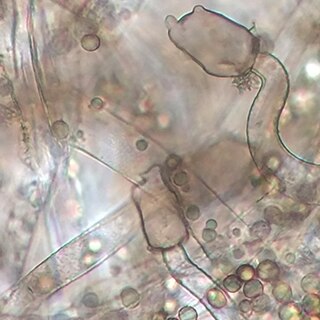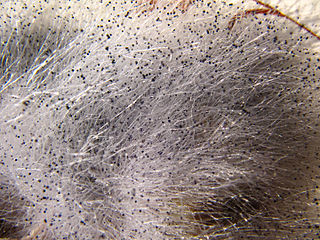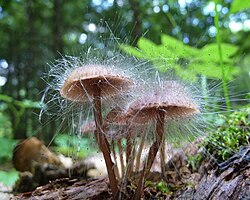
In biology, a spore is a unit of sexual or asexual reproduction that may be adapted for dispersal and for survival, often for extended periods of time, in unfavourable conditions. Spores form part of the life cycles of many plants, algae, fungi and protozoa.

A sporangium ; pl.: sporangia) is an enclosure in which spores are formed. It can be composed of a single cell or can be multicellular. Virtually all plants, fungi, and many other lineages form sporangia at some point in their life cycle. Sporangia can produce spores by mitosis, but in nearly all land plants and many fungi, sporangia are the site of meiosis and produce genetically distinct haploid spores.

Zygomycota, or zygote fungi, is a former division or phylum of the kingdom Fungi. The members are now part of two phyla: the Mucoromycota and Zoopagomycota. Approximately 1060 species are known. They are mostly terrestrial in habitat, living in soil or on decaying plant or animal material. Some are parasites of plants, insects, and small animals, while others form symbiotic relationships with plants. Zygomycete hyphae may be coenocytic, forming septa only where gametes are formed or to wall off dead hyphae. Zygomycota is no longer recognised as it was not believed to be truly monophyletic.

Rhizopus is a genus of common saprophytic fungi on plants and specialized parasites on animals. They are found in a wide variety of organic substances, including "mature fruits and vegetables", jellies, syrups, leather, bread, peanuts, and tobacco. They are multicellular. Some Rhizopus species are opportunistic human pathogens that often cause fatal disease called mucormycosis. This widespread genus includes at least eight species.

Phycomyces is a genus of fungus in the Zygomycota phylum. They are known for their strong phototropism response and helical growth of the sporangium. The best studied species is Phycomyces blakesleeanus.

The Mucorales is the largest and best-studied order of zygomycete fungi. Members of this order are sometimes called pin molds. The term mucormycosis is now preferred for infections caused by molds belonging to the order Mucorales.

Mucor is a microbial genus of approximately 40 species of molds in the family Mucoraceae. Species are commonly found in soil, digestive systems, plant surfaces, some cheeses like Tomme de Savoie, rotten vegetable matter and iron oxide residue in the biosorption process.
Sporogenesis is the production of spores in biology. The term is also used to refer to the process of reproduction via spores. Reproductive spores were found to be formed in eukaryotic organisms, such as plants, algae and fungi, during their normal reproductive life cycle. Dormant spores are formed, for example by certain fungi and algae, primarily in response to unfavorable growing conditions. Most eukaryotic spores are haploid and form through cell division, though some types are diploid sor dikaryons and form through cell fusion.we can also say this type of reproduction as single pollination

Mucor mucedo, commonly known as the common pinmould, is a fungal plant pathogen and member of the phylum Mucoromycota and the genus Mucor. Commonly found on soil, dung, water, plants and moist foods, Mucor mucedo is a saprotrophic fungus found world-wide with 85 known strains. It is often mistaken for Rhizopus rots on fruits due to similar mould growth shape and colour. Contrastingly, however, Mucor mucedo is found to grow on a wide range of stored grains and plants, including cucumber and tomato. Discovered in Italy in 1729 by P.A. Micheli and later noted by Carl Linnaeus in 1753 in the Species Plantarum, Mucor mucedo was originally classified as Mucor vulgaris by Micheli but later classified synonymous under name Mucor mucedo. The species was redescribed as Ascophora mucedo by H.J. Tode in 1790 but this type resided in a stoloniferous habitat and was later made the type of new genus Rhizopus.

Mucor racemosus is a rapidly growing, weedy mould belonging to the division Mucoromycota. It is one of the earliest fungi to be grown in pure culture and was first isolated in 1886. It has a worldwide distribution and colonizes many habitats such as vegetational products, soil and houses. The fungus is mostly known for its ability to exhibit both filamentous and yeast-like morphologies, often referred to as dimorphism. Stark differences are seen in both forms and conditions of the environment heavily affect the phases of the M. racemosus. Like many fungi, it also reproduces both sexually and asexually. The dimorphic capacity of this species has been proposed as an important factor in its pathogenicity and has enhanced the industrial importance. This species is considered an opportunistic pathogen, generally limited to immunocompromised individuals. It also been associated with allergy and inflammations of facial sinuses. Its association with allergy has made it a common fungus used in allergen medical testing. Industrial use of the fungus is in the production of enzymes and the manufacture of certain dairy foods.

Fuligo septica is a species of slime mold, and a member of the class Myxomycetes. It is commonly known as scrambled egg slime, or flowers of tan because of its peculiar yellowish appearance. It is also known as dog vomit slime mold or Jasmine mold and is relatively common with a worldwide distribution, often being found on bark mulch in urban areas after heavy rain or excessive watering. Their spores are produced on or in aerial sporangia and are spread by wind.

Mycena polygramma, commonly known as the grooved bonnet, is a species of mushroom in the family Mycenaceae. The inedible fruit bodies are small, pale gray-brown mushrooms with broadly conical caps, pinkish gills. They are found in small troops on stumps and branches of deciduous and occasionally coniferous trees. The mushroom is found in Asia, Europe, and North America, where it is typically found on twigs or buried wood, carrying out its role in the forest ecosystem by decomposing organic matter, recycling nutrients, and forming humus in the soil. M. polygramma contains two uncommon hydroxy fatty acids and is also a bioluminescent fungus whose intensity of light emission follows a diurnal pattern.

Lichtheimia corymbifera is a thermophilic fungus in the phylum Zygomycota. It normally lives as a saprotrophic mold, but can also be an opportunistic pathogen known to cause pulmonary, CNS, rhinocerebral, or cutaneous infections in animals and humans with impaired immunity.

Mucor plumbeus is a fungus in the family Mucoraceae that is very common, abundant and distributed worldwide. Mucor plumbeus is not known to be a plant or animal pathogen; however it is able to elicit an immune response in humans by activating the complement system. This species is commonly found in various types of soils over a range of pH, although alkaline soils seem more conducive to its growth. It is also known from the roots of wheat, oat and barley. In addition, M. plumbeus is a common fungal contaminant of indoor built environments. This species shares many similarities with M. racemosus, another fungus that belongs to the family Mucoraceae which is known to cause mucormycosis. Mucor plumbeus is a common spoilage agent of cheese, apples, apple cider and yogurt.
Cunninghamella bertholletiae is a species of zygomycetous fungi in the order Mucorales. It is found globally, with increased prevalence in Mediterranean and subtropical climates. It typically grows as a saprotroph and is found in a wide variety of substrates, including soil, fruits, vegetables, nuts, crops, and human and animal waste. Although infections are still rare, C. betholletiae is emerging as an opportunistic human pathogen, predominantly in immunocompromised people, leukemia patients, and people with uncontrolled diabetes. Cunninghamella bertholletiae infections are often highly invasive, and can be more difficult to treat with antifungal drugs than infections with other species of the Mucorales, making prompt and accurate recognition and diagnosis of mycoses caused by this fungus an important medical concern.

Rhizopus stolonifer is commonly known as black bread mold. It is a member of Zygomycota and considered the most important species in the genus Rhizopus. It is one of the most common fungi in the world and has a global distribution although it is most commonly found in tropical and subtropical regions. It is a common agent of decomposition of stored foods. Like other members of the genus Rhizopus, R. stolonifer grows rapidly, mostly in indoor environments.

Mucor circinelloides is a dimorphic fungus belonging to the Order Mucorales. It has a worldwide distribution, found mostly in soil, dung and root vegetables. This species is described as not known to be able to produce mycotoxins, however it has been frequently reported to infect animals such as cattle and swine, as well as fowl, platypus and occasionally humans. Ketoacidotic patients are particularly at risk for infection by M. circinelloides.

Mortierella polycephala is a saprotrophic fungus with a wide geographical distribution occurring in many different habitats from soil and plants to salt marshes and slate slopes. It is the type species of the genus Mortierella, and was first described in 1863 by Henri Coemans. A characteristic feature of the fungus is the presence of stylospores, which are aerial, spiny resting spores (chlamydospores).

Syzygites is a monotypic genus in Zygomycota. The sole described species is Syzygites megalocarpus, which was the first fungus for which sex was reported and the main homothallic representative in the research that allowed for the classification of fungi as homothallic or heterothallic. It is also the fungus from which the term "zygospore" was coined.

Mucoromycota is a division within the kingdom fungi. It includes a diverse group of various molds, including the common bread molds Mucor and Rhizopus. It is a sister phylum to Dikarya.















